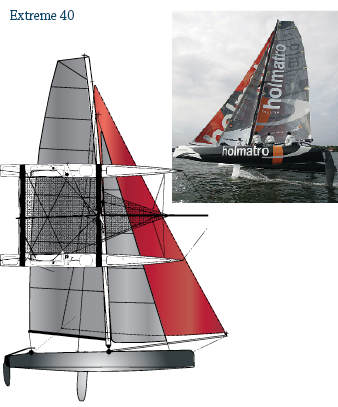Extreme 40, Originally reviewed August 2006
Racing catamaran

I agonized over whether to include any multihulls in the "final four." Ian Farrier's work with folding trimarans is hard to dismiss. There is also a whole world of big cruising cats out there that did not exist 35 years ago. And to top it off, the America's Cup will be sailed in radical, 72-foot, wing-sail cats this time.
When I initially reviewed this catamaran design by Yves Loday the material focused on the Extreme racing circuit as they followed the Volvo 70s in their around-the-world race series. The Extreme 40s would show up at the finishing port and put on a show of blinding boat speed to help draw attention to the Volvo 70 series. But when you look at the list of teams that raced the Extreme 40s and compare that to the list of America's Cup teams now racing AC45 cats it occurs to me that the Extreme 40 series was maybe more of a warm-up series, getting AC skippers and crews who were more accustomed to racing fast monohulls in tune with the demands of racing a super fast big cat.
The Extreme 40's hulls are very narrow with an individual L/B of 13.6. The stems are plumb and not the wave-piercing type you see on the AC45 cats. In my initial review I said the bows are "the surface piecing type." I wonder what bow isn't "surface piercing." Clearly, when you watch the AC45s in action their bows are designed to go through the waves and not over the waves. Of course when pushed a bit too hard the leeward bow can dig in, causing very spectacular pitchpole events. I have noted that all the AC45 crews now wear helmets. The D/L for the Extreme 40 is the lowest I have calculated in 35 years of using D/Ls: 19.18 without crew and 25.46 with crew weight added.
The rig of the Extreme 40 also set the record for the highest SA/D I have ever calculated. With main, jib and crew weight the SA/D is 72.62. That's four times the horsepower-per-pound of a cruiser/racer from the mid 1970s. If you calculate the SA/D with the genniker you get an SA/D of 129.25. This type of power combined with the narrow hulls results in a top speed for the Extreme somewhere between 35 and 40 knots in 25 knots of breeze. Probably the biggest difference between the Extreme 40 and the AC45s and AC72s is that the Extreme uses conventional "soft" sails instead of the big wing we see on the AC45.
Of course capsizes will be frequent and usually spectacular as crewmembers try to cling to the webbing of the trampoline to avoid the 23-foot fall onto a nice hard piece of carbon fiber structure. I am very excited to see how all this works when it's translated into the 72-foot AC cats that will have up to 46 feet of beam. I can hardly wait.
Boats like this are only possible with extreme materials and building methods. But in the world of ultra-fast cats these methods and materials are almost commonplace now. The hulls and structural members are all carbon fiber with Nomex Aramid honeycomb cores. The Extreme is then rolled into an autoclave where a vacuum is drawn and the pieces are heated to 120 degrees Celsius. The resulting boats will be very strong but not very durable. But I like the fact that there is a class exploring the very edges of what can be done with sailing craft. Of course there are the "one-way proas" that are now sailing at over 50 knots with some really spectacular crashes. But the Extreme cat and the AC45 and AC72 will have to sail a course around buoys, upwind and down.
All this does make me wonder what the Extreme 40 cats will look like at the end of another 35 years.
Read the original review at: http://www.sailingmagazine.net/component/content/article/3-perry-on-design/1093-volvo-extreme-40?directory=138
LOA 40'; LWL 40'; Beam 23'; Draft 6'; Displacement 2,750 lbs.; Sail area 1,076 sq. ft.
Original sailaway price $385,000

Comments